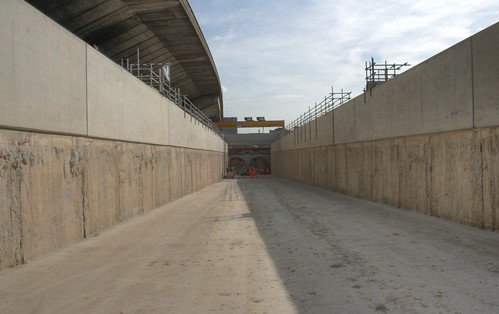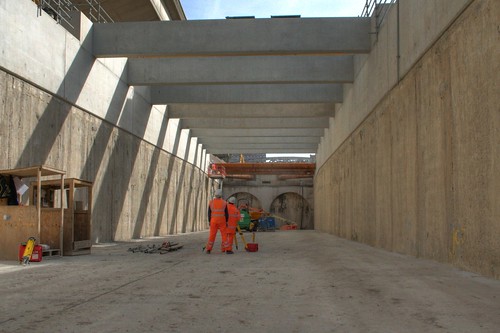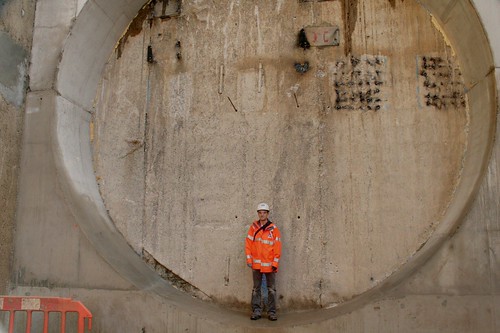In around 2018, when the first Elizabeth line passengers come into London from the West, they leave the existing overland railway near Royal Oak tube station and dip down into the tunnels that will run under the city.
In order for the tunnels to line up with the overland tracks, a “portal” is being constructed at Royal Oak, and next Springtime, the tunnel boring machines will slowly slip down and start drilling their way towards Farringdon Station.
Construction started last April, and today was a chance to have a look at the finished structure – which is the first bit of the Crossrail network that will carry passengers to be completed. It looks like and frankly is, just a big concrete box in the ground, but that simplicity hides a really quite difficult working site.
The main challenge at Royal Oak was working within a constrained worksite. With the Hammersmith & City line railway running along one side of the site and the A40 on the other, and they worked on a worksite that is just 22 metres wide.
In addition, when digging down, you have the potential risk of the side walls collapsing inwards, which would have probably taken out both the main road and the tube line and been the lead story on the evening news. Not ideal.
Around 25,000 cubic metres of soil have been removed — some of it ending up on a golf course — and the walls were at the shallow end made from steelplates and in the deeper end, a steel and concrete cage. During construction, there is also a second steel plate wall that protects the tube trains from accidents on site.
One amusing downside of working next to the flyover road is that when it snowed last year, as lorries when past above, occasionally small avalanches of snow fell down onto the building site.
As the soil was being removed, 45 temporary props held the walls apart until the main concrete floor could be cast, although 9 props will remain at the deepest point to support the walls. That floor has to be thick – at 1.7 metres to be strong enough to support the side walls. It’s also strong enough to land an aircraft on. In theory.
Apparently, movement has been less than 2mm, which is quite good for a structure of this sort.
Above the portal entrance will eventually be a building for services and electricity works, as well as space below for passenger evacuations should something icky happen.
Other works included raising a local footbridge (which will need to be lifted again for each TBM delivery next year), diversion works for London Underground drainage pumps and a local sewer.
They also found 160 bones including a rare prehistoric ox.
At the deepest end of the portal, where the box turns into tunnels, two circular holes are ready to receive steel rings. When the TBMs are delivered they will slot into the steel rings and push off from the floor of the portal and start their drilling works.
One starts around March time – probably the tunnel towards London on the left – and the second one a month or so later.
Excavated material from the platform and running tunnels will be taken out via the Royal Oak Portal rather than be transported by lorry through London’s streets.
As mentioned when visiting the mock-up station, that also applies to the station spoil, which was a change from the original plan to dig the stations before the TBMs arrive, and carry the soil away by lorry.
The soil will be taken around North London to Kent, then by barge to Wallasea Island in Essex where it will be used to create a wildlife reserve. In total, five tunnel portals will be constructed as part of Crossrail – at Royal Oak, Pudding Mill Lane, Victoria Dock, North Woolwich and Plumstead.
The total cost of this portal was £25 million, and it was completed 20 days earlier than scheduled.
A lot more photos over in the photo gallery.
Thanks to Crossrail for letting us on site, it does disrupt the builders when we want to take our photos, and one was kind enough to take a couple of us up in the ramp lift to get a bird’s eye view of the site.
Previous Crossrail site visits/lectures can be found here.













Any idea why the tunnel portals are so large? Each of them almost looks big enough to carry two trains!
Note that the bottom quarter will be filled in to create a flat floor, but the main reason is that they will be carrying full size overland trains.
I can’t make out that diagram at all. It seems to be suggesting that the H&C will be moved into a deep cutting beneath the Crossrail lines…?
Of course, the C stock illustrated there will have been scrapped by the time Crossrail starts running…
At the point where the side view is taken, the LUL line is in a cutting, as it has to duck under the mainline services at that location.
and by then a thriving community business in Great Western road in a beautiful iconic building will have been destroyed and demolished to be replaced by NOTHING!
Does this imply that cross rail station entrance will be from royal oak ?
or will it be from paddington ?
The Paddington Station exits will be in Paddington – not a mile away in Royal Oak.